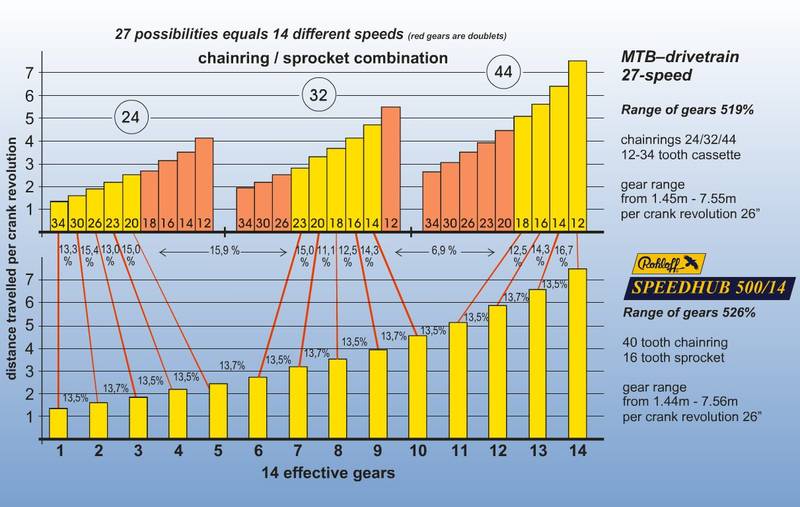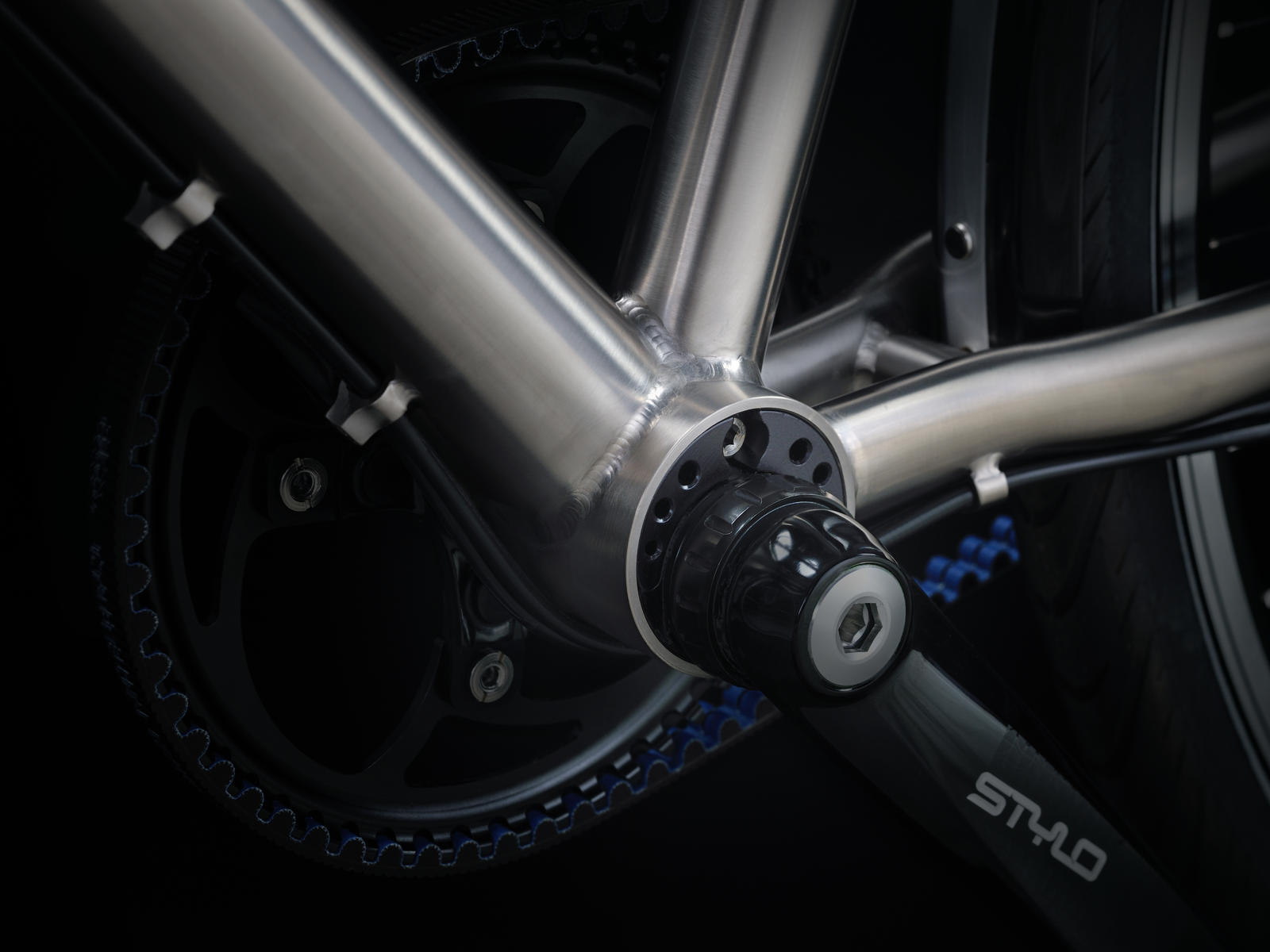Rohloff Speedhub: Pros and Cons
Feb 25, 2019A Rohloff hub may be the single component that has the most dramatic effect on a bike’s performance. This one item changes a bike’s shifting, wheel strength, weight, mechanical efficiency, and changes the amount and type of maintenance the bike will need.
After doing plenty of touring on both a Rohloff hub and a typical chain-and-derailleur drivetrain, here’s my take on the Rohloff.
Pros
Shifting
On most bikes, a grip shift is used. This may not seem like a big deal, but it’s nice to wear mittens without shifting getting any more difficult.
Since the chain doesn’t need to hop gear-to-gear, it’s nearly impossible to miss a shift, and gear changes happen almost instantly. Also, say goodbye to dropped chains.
A Rohloff allows you to shift even when the bike is entirely stopped. In fact, shifting is a little smoother if you’re either pedaling lightly or not at all, so you eventually get in the habit of backing off your pedal stroke for half a second while you shift. This may not seem like a big deal, but it’s hard to understate how convenient it is to be able to shift down after you’ve come to a complete stop. I find myself doing this at least once or twice per ride, usually after some kind of sudden or unexpected stop. When your bike is fully loaded for touring, it sucks having to start off in the wrong gear, especially on an uphill or in a busy intersection.
The Rohloff has 14 gears, each roughly 13.6% higher than the previous one, for a total range of 526%. That means the highest gear ratio is 5.26 times greater than the lowest gear ratio. For comparison, that provides about the same range as a mountain bike, with more gears and a smaller step size than modern 1x11 mountain bike drivetrains. Exactly what are your highest and lowest gear ratios is determined by the relative size of your front and rear cogs.

For touring purposes, the range of gearing is more than enough, the spacing between gears is a reasonable size, and the convenience of shifting at any time is more valuable than you might think.
Maintenance
Perhaps the greatest advantage of a Rohloff drivetrain is the lack of needed maintenance.
A Rohloff can be used with a belt drive, eliminating the need to keep your chain clean and lubricated, as well as the need to replace your chain after stretching. A belt drive will eventually break and (obviously) need replacement, but in that time, you’d likely go through 3-4 chains. Unless your tour involves crossing multiple continents, a new belt will easily last start-to-finish with no maintenance whatsoever. Even if you decide to carry a spare belt, they’re lightweight, flexible, and easy to stash in your panniers.

Even if you’re using a chain, the low maintenance of a Rohloff is still a draw. With no derailleurs, there are fewer delicate components and moving parts that might break. Derailleur hangers, in particular, can bend after taking a strong hit, wreaking havoc on your shifting. A Rohloff drivetrain doesn’t require a derailleur hanger, and you can’t bend one when you don’t have one. The hub itself is the only moving part in the drivetrain, and the Rohloff Speedhub has an incredible track record of never breaking down.
Even your shifting cables will last an extraordinarily long time before breaking, but we’ll revisit that topic later (unfortunately).
Wheels
An often-overlooked benefit to a Rohloff hub is the effect it has on your rear wheel.
Most rear wheels are dished, meaning the spokes are asymmetrical when looking straight down the rim. This is to make room for the cassette on one side of the rear hub. Generally, a wheel will be stronger if the spokes are able to flare outwards. That’s possible on one side of a dished wheel, but not on the drive side. As a result, wheelbuilders take the strength where they can get it on the non-drive side, but there’s no way around the fact that a dished wheel isn’t as strong as a symmetrical one.
To make matters worse, a rear wheel needs to be stronger. On most bikes, roughly two-thirds of a rider’s weight will be on the rear wheel, vs. one-third on the front. Most touring setups follow roughly the same proportions: smaller panniers up front, larger ones on the rear, and possibly an extra duffel bag or tent on top of the rear rack. The rear wheel is also the drive wheel, adding torsional forces into the mix.
To make up for the weakness of a dished wheel, the additional weight, and the torsion due to the driving force of the bike, most wheelsets are built with more spokes on the rear wheel. Even then, the rear wheel is much more likely to experience some kind of failure than the front wheel. In addition, this results in the wheels having a total of three spoke lengths between them: front, rear drive side, rear non-drive side. A prudent touring cyclist will carry at least one each of these spokes, perhaps two.
A Rohloff system has no rear cassette, and therefore, the rear wheel can be laced symmetrically like a front wheel. This makes for a much stronger wheel and reduces the amount of lengths of spokes in use. Chances are the front and rear will still have different spoke lengths, since the hub flanges will likely be different sizes, but that’s still one less thing to keep track of.
I’ve toured over 30,000 km using 32 spokes on both front and rear, and not once has a wheel even gone out of true. While good rims, good spokes, and a skilled mechanic were all key contributors to that, I’m fairly certain the rear wheel’s symmetry, thanks to the Rohloff hub, was equally important.
Cons
Weight
A Rohloff hub is heavy. Exactly how heavy depends on the model, but roughly 1.8 kg (4.0 lbs) is typical. Mind you, that’s only for the hub; including the shifter, brake levers, belt drive, and front and rear cogs would bring the total to roughly 2.4 kg (5.3 lbs). By comparison, a Shimano 105 drivetrain has a total weight of 1.5 kg (3.3 lbs), comparing all the equivalent parts (leaving out crank arms, bottom bracket, and cables). That’s an additional 0.9 kg (2.0 lbs) on the bike.
People spend a lot of money to reduce the weight of their bike by 100 grams, and this component alone adds nearly ten times that. While touring bikes aren’t lightweight to begin with, an entire kg is enough to notice.
The additional weight gets added almost exclusively to one place: the rear hub. In some cases, this may not matter, but most touring bikes are already too tail-heavy, and the Rohloff only makes that problem worse.
Efficiency
There are varying reports on this, but the general consensus is a Rohloff hub is, on average, less mechanically efficient than a traditional chain-and-derailleur system. Rohloff claims their drivetrain is more efficient, but most third-party tests seem to indicate it’s less.
The difference is somewhat minor; the total energy loss is generally estimated to be an additional 1% compared to a traditional drivetrain. Considering each gear is 13.6% higher than the gear below it, that makes a difference of less than 10% compared to being one gear slower. That said, if some especially long days were 1% easier, you’d notice.
The Rohloff hub’s zero-maintenance properties probably mitigate this difference, perhaps to the point of being more efficient in the field, while still being less efficient in the lab. In a traditional drivetrain, chains can stretch and rust, derailleurs can get caked in mud, and a poorly-tuned bike may have the chain rubbing on the derailleur, or the derailleur may be holding the chain somewhat in between gears. None of this is an issue for a Rohloff hub, which performs nearly the same in all conditions.
All that said, after riding both systems, a traditional system feels like there’s less energy loss when I’m stomping on the pedals. It’s also strange how quickly the rear wheel slows to a stop when you spin it on a workstand. Rohloff claims this isn’t an issue when the hub is under load, but I have my doubts.
Maintenance
Rohloff hubs don’t need maintenance often, but when they do, good luck!
Nearly any service needed is going to require you to take your bike to a shop. And not just any shop, either. From my experience, only about half of all bike shops will even attempt to work on a Rohloff hub, and even then, they might have only one guy who knows how. Don’t expect a quick turnaround when your Rohloff hub needs maintenance.
Due to a shoddy job building the bike (long story), my shifting cable snapped after an unusually short 3,000 km of riding. After trying for 20 minutes, I couldn’t even figure out how to remove the old cable. Fortunately, I was just outside a mid-sized town and managed to hitchhike to a bike shop. The mechanic there tried installing a new cable for an hour, then told me to come back the next day. He was eventually able to install the new cable correctly, and it lasted over 20,000 km.
Replacing a cable while on tour is a major hassle, but if you start your tour with a new cable (installed by a competent mechanic), you can complete all but the very longest of tours with peace of mind and without even carrying a spare.
Rohloff hubs also need their oil changed every so often. Rohloff recommends doing this every 5,000 km, or once a year minimum. I’ve gone 30,000 km and three years between changes without experiencing a problem, but the shifting and pedaling felt a lot better after the oil change. Like replacing a cable, this is something you won’t want to do on tour, but if you get the maintenance done beforehand and start your tour fresh, there should be no problems.
Compatibility
The Rohloff hub is obviously a specialty item, but nearly everything used with it - shifter, belt, front and rear cogs, disc rotor - are also specialty items. If you’re ever in need of a new rotor, you can’t simply get a new six-bolt rotor and stick it on. You’ll have to special order a Rohloff-compatible one.
I’ve only had to replace two of these: the belt and the rear cog. The cog had to be done by a shop, but the belt I replaced myself while on tour. It’s easier than installing a new chain and requires no tools.

Not only are most of the parts on your bike going to be specialty items, the same is true of the frame itself. With no derailleur, belt tension has to be achieved through other means. Most commonly, this is done with either slider dropouts (see above) or an eccentric bottom bracket (see below), both of which will add even more to the additional weight caused by the Rohloff hub. If you want a bike with a Rohloff hub, you’ll have to start with a frame that’s compatible. Most aren’t.

Price
Rohloff hubs aren’t cheap, usually running about $1,300. You can buy a perfectly good touring bike for less. Considering that’s $1,300 being spent to make your bike heavier, possibly less efficient, and in some ways more difficult to maintain, it’s worth asking whether or not it’s worth the money.
Verdict
I love my Rohloff hub and the bike it’s on. Valeria was built with the goal of being a bike that would last a lifetime with minimal, if any, upgrades made along the way. Five years later, we’re still on schedule, and she remains my favorite bike to ride, even if she’s not my fastest.
If I were to start over from scratch, I’d probably stick to a traditional drivetrain. Rohloff hubs are awfully expensive, and for my money, $1,300 needs to be an upgrade with no drawbacks.
Whether or not a Rohloff drivetrain is right for you is something you’ll have to decide for yourself. If money’s not an issue and you like the idea of a zero-maintenance bike, both in terms of a drivetrain and a stronger rear wheel, a Rohloff hub is an excellent choice. If you like widespread compatibility and you spend frugally, maybe not.
